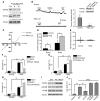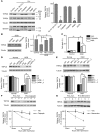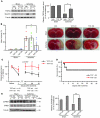Inhibition of TRPC6 degradation suppresses ischemic brain damage in rats
- PMID: 20811149
- PMCID: PMC2947234
- DOI: 10.1172/JCI43165
Inhibition of TRPC6 degradation suppresses ischemic brain damage in rats
Abstract
Brain injury after focal cerebral ischemia, the most common cause of stroke, develops from a series of pathological processes, including excitotoxicity, inflammation, and apoptosis. While NMDA receptors have been implicated in excitotoxicity, attempts to prevent ischemic brain damage by blocking NMDA receptors have been disappointing. Disruption of neuroprotective pathways may be another avenue responsible for ischemic damage, and thus preservation of neuronal survival may be important for prevention of ischemic brain injury. Here, we report that suppression of proteolytic degradation of transient receptor potential canonical 6 (TRPC6) prevented ischemic neuronal cell death in a rat model of stroke. The TRPC6 protein level in neurons was greatly reduced in ischemia via NMDA receptor-dependent calpain proteolysis of the N-terminal domain of TRPC6 at Lys¹⁶. This downregulation was specific for TRPC6 and preceded neuronal death. In a rat model of ischemia, activating TRPC6 prevented neuronal death, while blocking TRPC6 increased sensitivity to ischemia. A fusion peptide derived from the calpain cleavage site in TRPC6 inhibited degradation of TRPC6, reduced infarct size, and improved behavioral performance measures via the cAMP response element-binding protein (CREB) signaling pathway. Thus, TRPC6 proteolysis contributed to ischemic neuronal cell death, and suppression of its degradation preserved neuronal survival and prevented ischemic brain damage.
Figures







Similar articles
-
Hyperforin attenuates brain damage induced by transient middle cerebral artery occlusion (MCAO) in rats via inhibition of TRPC6 channels degradation.J Cereb Blood Flow Metab. 2013 Feb;33(2):253-62. doi: 10.1038/jcbfm.2012.164. Epub 2012 Nov 14. J Cereb Blood Flow Metab. 2013. PMID: 23149561 Free PMC article.
-
Neuroprotectin D1 attenuates brain damage induced by transient middle cerebral artery occlusion in rats through TRPC6/CREB pathways.Mol Med Rep. 2013 Aug;8(2):543-50. doi: 10.3892/mmr.2013.1543. Epub 2013 Jun 25. Mol Med Rep. 2013. PMID: 23799606
-
TRPC6 inhibited NMDA receptor activities and protected neurons from ischemic excitotoxicity.J Neurochem. 2012 Dec;123(6):1010-8. doi: 10.1111/jnc.12045. Epub 2012 Nov 1. J Neurochem. 2012. PMID: 23043486
-
Novel Mechanistic Insights and Potential Therapeutic Impact of TRPC6 in Neurovascular Coupling and Ischemic Stroke.Int J Mol Sci. 2021 Feb 19;22(4):2074. doi: 10.3390/ijms22042074. Int J Mol Sci. 2021. PMID: 33669830 Free PMC article. Review.
-
Neuroprotection by cell permeable TAT-mGluR1 peptide in ischemia: synergy between carrier and cargo sequences.Neuroscientist. 2008 Oct;14(5):409-14. doi: 10.1177/1073858407309762. Epub 2007 Nov 13. Neuroscientist. 2008. PMID: 18000067 Review.
Cited by
-
The effect of triple reuptake inhibitor toludesvenlafaxine on neurological function in cerebral ischemic rats.Front Pharmacol. 2023 Apr 21;14:1073099. doi: 10.3389/fphar.2023.1073099. eCollection 2023. Front Pharmacol. 2023. PMID: 37153779 Free PMC article.
-
Canonical Transient Receptor Potential Channels and Their Link with Cardio/Cerebro-Vascular Diseases.Biomol Ther (Seoul). 2017 Sep 1;25(5):471-481. doi: 10.4062/biomolther.2016.096. Biomol Ther (Seoul). 2017. PMID: 28274093 Free PMC article. Review.
-
Acid Sphingomyelinase Impacts Canonical Transient Receptor Potential Channels 6 (TRPC6) Activity in Primary Neuronal Systems.Cells. 2020 Nov 18;9(11):2502. doi: 10.3390/cells9112502. Cells. 2020. PMID: 33218173 Free PMC article.
-
Interleukin-17 and ischaemic stroke.Immunology. 2021 Feb;162(2):179-193. doi: 10.1111/imm.13265. Epub 2020 Oct 7. Immunology. 2021. PMID: 32935861 Free PMC article. Review.
-
Transmembrane insertases and N-glycosylation critically determine synthesis, trafficking, and activity of the nonselective cation channel TRPC6.J Biol Chem. 2019 Aug 23;294(34):12655-12669. doi: 10.1074/jbc.RA119.008299. Epub 2019 Jul 2. J Biol Chem. 2019. PMID: 31266804 Free PMC article.
References
-
- Lo EH, Dalkara T, Moskowitz MA. Mechanisms, challenges and opportunities in stroke. Nat Rev Neurosci. 2003;4(5):399–415. - PubMed
-
- Lipton P. Ischemic cell death in brain neurons. Physiol Rev. 1999;79(4):1431–1568. - PubMed
-
- Hoyte L, Barber PA, Buchan AM, Hill MD. The rise and fall of NMDA antagonists for ischemic stroke. Curr Mol Med. 2004;4(2):131–136. - PubMed
Publication types
MeSH terms
Substances
LinkOut - more resources
Full Text Sources
Other Literature Sources

